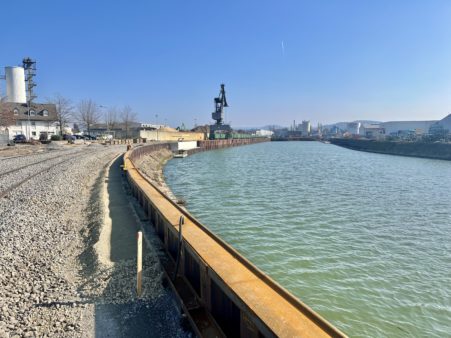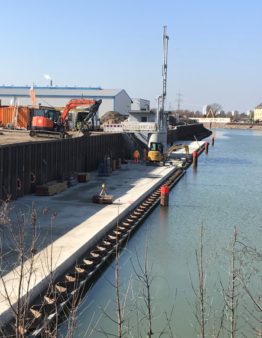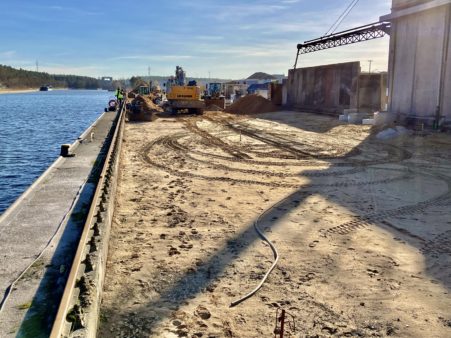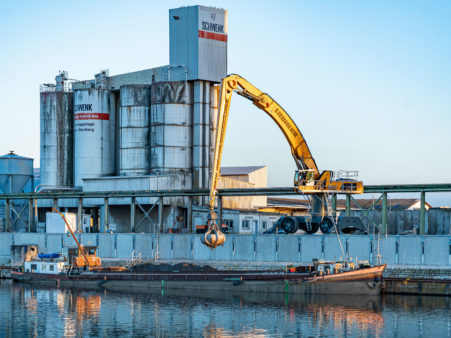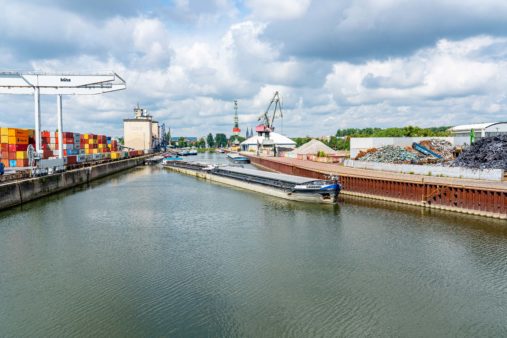6 March 2023 | bayernhafen
“bayernhafen and its locations act as the backbone for the supply of goods to society and industry.”
2022 financial year: around 9 million tonnes of goods moved by inland waterway and rail. Record in combined transport: at 512,000 TEU, bayernhafen cracks the half a million mark
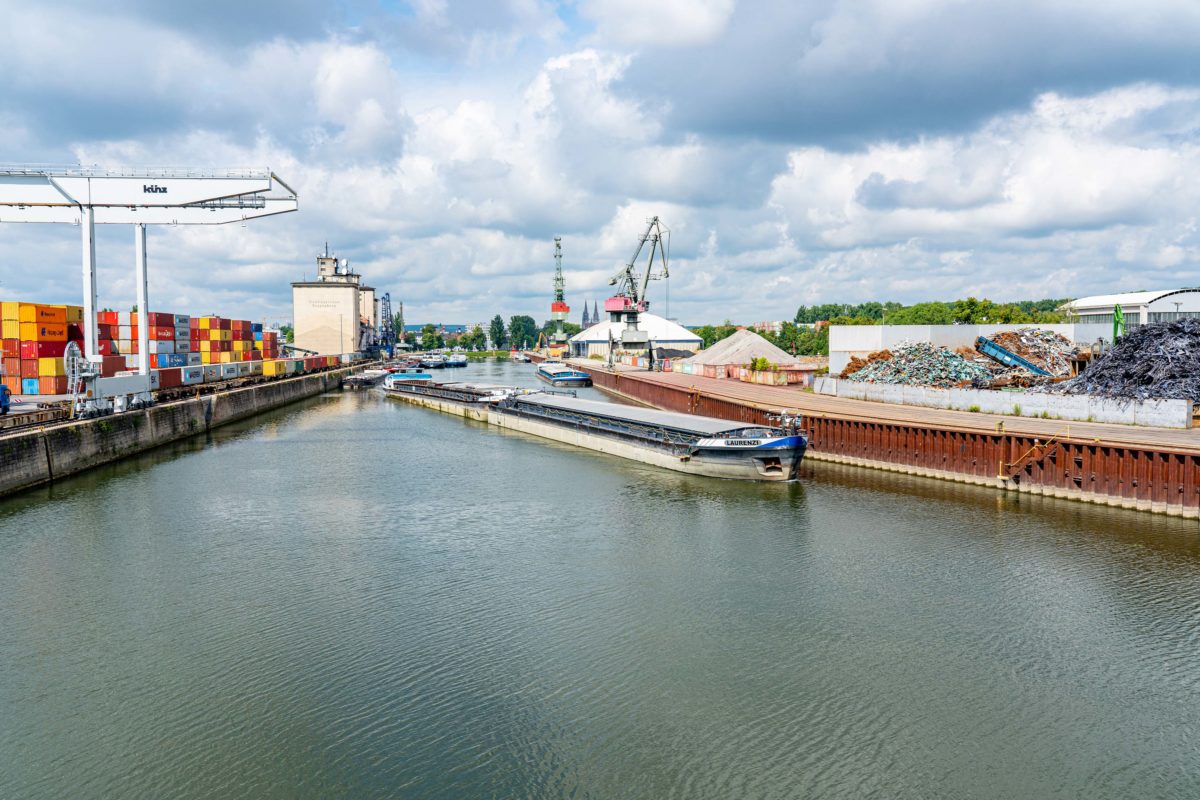
The expansion of the container terminal (pictured left) at bayernhafen Regensburg has given combined transport a significant boost. A high-performance logistics infrastructure is indispensable for the export-driven economy in the Regensburg region. (image source: bayernhafen / Michael Ziegler)
Regensburg, 06.03.2023 – Despite 2022 being a difficult year, bayernhafen showed what it was capable of: 520,000 road trips (1,420 per day) were saved by shifting long-distance traffic to the more environmentally friendly modes of transport, rail and inland waterway. bayernhafen moved a total of 9 million tonnes of cargo and freight by inland waterway and rail at its six locations of Aschaffenburg, Bamberg, Nuremberg, Roth, Regensburg and Passau – at 1.8%, only slightly less than the previous year.
6,559 million tonnes of goods were moved by rail in 2022 – a 2.5% increase on 2021, despite infrastructure issues. Inland waterway handling fell 12% to 2.424 million tonnes. This was caused by three factors. Around 120,000 tonnes of shipping capacity are currently missing due to sales of ships to Eastern Europe, where they are mainly used to transport grain from Ukraine. Further capacity is also lacking on the Main and Danube rivers from Aschaffenburg to Passau due to the enormous amount of returned coal shipments in the Rhine region. Lastly, 2022 was a year of severe and prolonged low water periods due to the hot summer.
We act as the backbone for the supply of goods to society and industry.
Joachim Zimmernann
Chief Executive Officer of bayernhafen
“Despite the challenges, however, we are seeing considerable interest and a fundamental willingness to expedite the change to inland waterway and rail for transport, not only among our customers but also among companies in Bavaria. To ensure that bayernhafen remains the first port of call, last year we again initiated around €46 million in multi-year investments in our port infrastructure, and this year we’re adding another €28 million,” says bayernhafen’s Chief Executive Officer, Joachim Zimmermann, who is also President of the Federal Association of Public Inland Ports. “However, the responsibility for ensuring that these investments deliver their full impact at our port locations does not end with us. We need accelerated approvals for our projects and, most importantly, we need protection for our infrastructure. We act as the backbone for the supply of goods to society and industry. This function should not be constrained or even harmed. From urban residential development and conversion for cultural use to the construction of an ICE maintenance plant in the port basin with the associated displacement of customers and loss of jobs, there are numerous issues on our agenda that we firmly oppose,” said Joachim Zimmermann.
Historical record
bayernhafen is proud to report an all-time record in combined transport. For the first time, the number of TEU (twenty foot equivalent unit) moved at all of its locations surpassed the half-million mark. The 512,036 TEU (up 4% on the previous year) include seaport-hinterland container transport as well as swap bodies and semi-trailers for continental traffic. The trimodal terminal (road, rail and inland waterway) in Regensburg, which was completed in 2022, and the upcoming expansion of the terminal in Nuremberg mean that there is also room for further growth in the future. Regensburg increased its capacity by more than 50% from 128,000 TEU to 200,000 TEU. €26 million was invested in the expansion of the terminal and a new trimodal gantry crane.
The return of river cruises after the pandemic is also developing very positively, with 2,054 ships calling in at bayernhafen’s piers. This figure is only 16% below the pre-Corona figures from 2019. Despite the recovery, however, the situation for river cruises in general is still strained due to the shortage of personnel: previously many crews and workers were recruited from Ukraine.
Without the logistics hub inland port, the transition to cleaner modes of transport is not feasible.
Joachim Zimmernann
Chief Executive Officer of bayernhafen
“We are pleased to hear many politicians acknowledge that inland ports are systemically important, but these statements must now be followed by decisive action, especially on the part of the German government. Without the logistics hub inland port, the transition to cleaner modes of transport is not feasible. To achieve this, we need a level playing field for all modes of transport. The decades-long neglect of waterways must be brought to an end. Muddling through from budget to budget with increasingly reduced funds is just not acceptable anymore,” says bayernhafen’s Chief Executive Officer, Joachim Zimmerman. “If they truly want to achieve the transition to cleaner modes of transport, policymakers will not only have to accelerate going forward, but actually work at the speed of light, and massively increase the budget allocated to our waterways. There is virtually no spare capacity left on the rail network, and the long overdue modernisation of the DB network will cause additional bottlenecks in the coming years. Where possible, therefore, inland waterway vessels should be used to transport bulk goods rather than trains, so that the freed-up rail capacity can be used for combined transport trains. Barges are also ideal for large-volume and heavy-lift transport.”
Investment in the future
The most significant investments this year include projects in Aschaffenburg and Nuremberg and the location-wide HVO refueling project launched in Bamberg. bayernhafen is taking the next step in sustainability by gradually converting its handling equipment to HVO fuel. HVO stands for hydrotreated vegetable oils, or also hydrogenated vegetable oil. This type of organic fuel can be used to completely replace normal diesel. The use of HVO reduces the total amount of harmful emissions in the life cycle of a machine by around 75%, and practically halves CO2 emissions, with the only emissions being those the plant had previously absorbed. This makes the vehicles climate-neutral. Since recycled fats and oils are used, it also means there is no competition with the food product sector.
A number of major infrastructure projects are nearing completion at the Port of Aschaffenburg. The projects are a prime example of how bayernhafen works hand in hand with its customers to modernise its ports. The work includes the complete revamping of the quay walls at quays 1 and 2 and the addition of a second rail track at the quay. This will considerably optimise the use of space for customers and, in addition, bayernhafen will significantly strengthen its own trimodal facilities (road, rail and inland waterway), enabling it to offer its services directly to even more companies outside the port in the future.
bayernhafen is also investing a double-digit million figure in its location in Nuremberg. At quay 1, around €2.3 million is being spent on upgrading the drainage infrastructure of the quay on the Main-Danube Canal to the latest modern standards over a length of 425 metres. This will include the installation of 6 large-scale treatment plants for sedimentation and rainwater filtration. The new rainwater system was designed by bayernhafen itself. The next step is to modernise the road and rail transport facilities at the quay to enable the use of mobile cargo handling equipment. This is where bayernhafen can fully exploit the advantage of having its own highly experienced engineering and planning team to implement projects more quickly. Work has already started on the tracks at the trimodal combined transport terminal in Nuremberg. The public tender for three new container cranes is in progress. This expansion is dearly needed as CT terminal is now already operating at the limits of its capacity. The expansion work will increase the capacity of the CT terminal, which was commissioned in 2006, by around 21% to handle 411,000 TEU per year.

